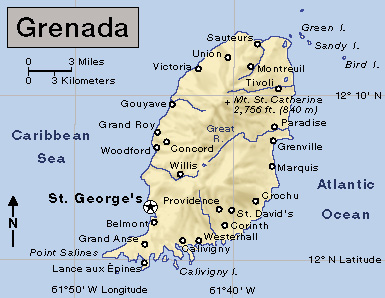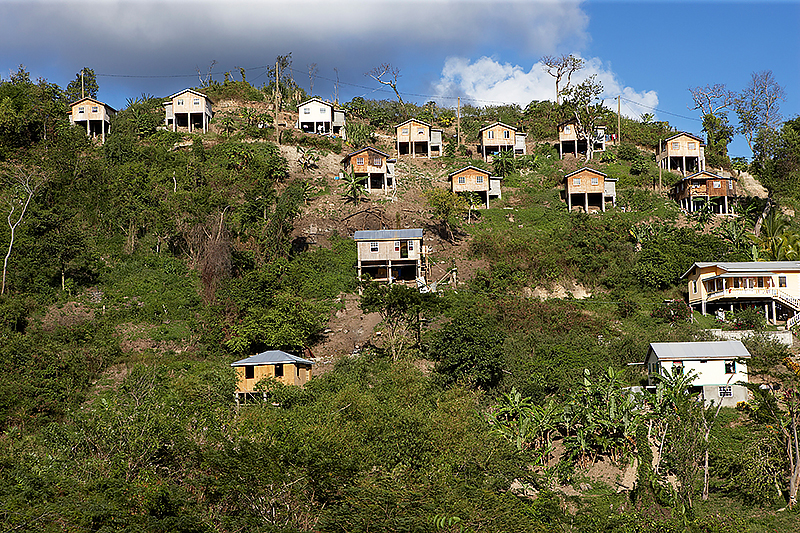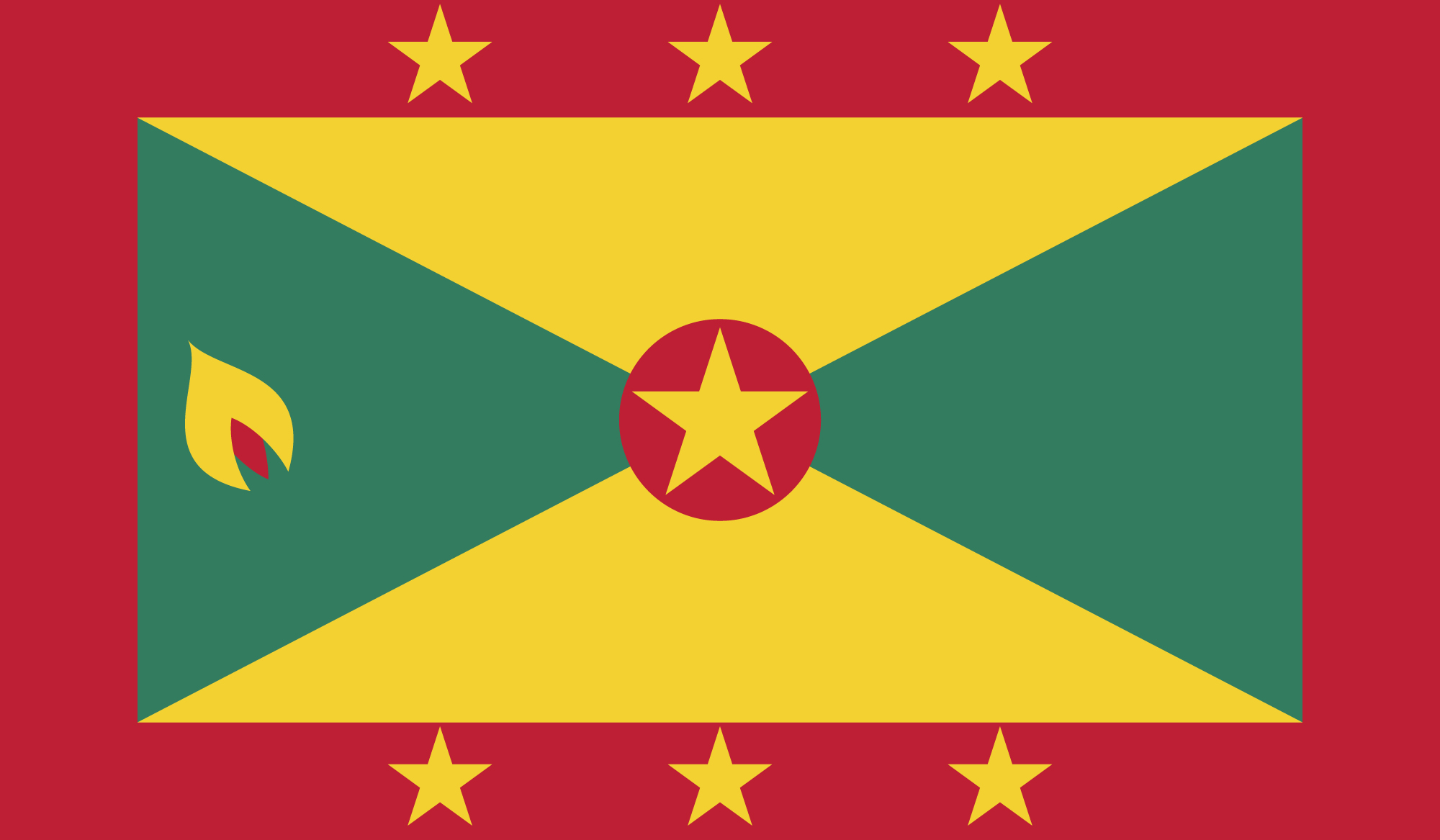Grenada << grih NAY duh >> is an island nation in the Caribbean Sea. It lies about 90 miles (140 kilometers) north of Venezuela. The country includes the main island of Grenada and several tiny nearby islands. It also includes the island of Carriacou, about 17 miles (27 kilometers) northeast of the main island, and several other small islands of the Grenadines island chain. St. George’s is Grenada’s largest city and capital.

Grenada’s tropical climate, beautiful scenery, and beaches attract many tourists. The nation is a leading producer of nutmeg and other spices. Grenada was a dependency of Britain (now the United Kingdom) from the late 1700’s to 1974, when it became independent.
People.

About 95 percent of Grenada’s people are of African ancestry, or have both African and European ancestry. Descendants of South Asians or of Europeans make up the rest of the population. The majority of Grenadians speak English, the nation’s official language, or a dialect (local form) of English. A French-African patois (mixture of languages) is also commonly spoken. More than half the people are Roman Catholics. Other religious groups include Anglicans, Methodists, and Seventh-day Adventists.
Children between the ages of 5 and 16 must attend school. Grenada’s government provides most of the funding for the country’s many public and technical schools. Grenada is home to a branch of the University of the West Indies.
Land and climate.
The mountainous, thickly forested countryside of the main island of Grenada has many gorges and waterfalls. Grand Etang, a lake in the crater of a volcano, lies near the center of the island.
Temperatures in Grenada seldom fall below 65 °F (18 °C) in winter or rise above 90 °F (32 °C) in summer. The coast of the main island receives up to 60 inches (150 centimeters) of rainfall each year. The mountain regions receive up to 200 inches (510 centimeters). The dry season in Grenada extends from January until May.
Economy
of Grenada is based chiefly on tourism and agriculture. Hundreds of thousands of tourists visit Grenada each year. Leading agricultural products include avocados, bananas, citrus fruit, cocoa, coconuts, nutmeg, sugar cane, and a spice called mace. Farmers raise chickens for eggs and meat. Manufacturing plays a relatively small role in Grenada’s economy. The country manufactures food and beverage products and clothing. The East Caribbean dollar is the basic unit of currency in Grenada.

Grenada imports more than it exports. Grenada imports automobiles, food, machinery, and petroleum. The island’s chief exports include cocoa, fish, flour, mace, nutmeg, and paper products. Other Caribbean nations and the United States rank as Grenada’s leading trade partners. In 1974, Grenada joined the Caribbean Community (CARICOM), an economic union of nations.
St. George’s is Grenada’s chief port, but the country also has several smaller ports. An international airport operates near St. George’s. The country has a few privately owned weekly newspapers. The government operates the country’s main radio and television stations.
History and government.
Indigenous (native) Arawak people were the first inhabitants of what is now Grenada. During the 1300’s, Indigenous Carib people from South America took over the main island. In 1498, Christopher Columbus became the first European explorer to land there. He named it Concepción, but other Europeans later called it Grenada. The Carib defeated early European efforts to colonize Grenada. The French claimed Grenada in 1650 and later slaughtered many of the Indigenous people. Some Carib killed themselves rather than submit to French rule.

Control of Grenada shifted between France and Britain several times before the island became a British colony in 1783. Through the years, European planters brought many Africans to Grenada and forced them to work on plantations. After the British ended slavery in 1833, South Asians came to live and work in Grenada.
In the 1960’s, the British gave Grenada control over its internal affairs. In the early 1970’s, colonial Premier Eric M. Gairy led a movement for independence. Political unrest developed because some groups opposed independence and accused Gairy of becoming a dictator. Grenada gained independence in 1974. The new country became a constitutional monarchy and joined the Commonwealth of Nations. A prime minister headed the government. A governor general, a symbolic official, was appointed by the British monarch.
Gairy served as prime minister of Grenada from 1974 to 1979, when rebels led by Maurice Bishop overthrew his government. The rebels set up a new government and named Bishop prime minister. Bishop, a Marxist, established close ties with Cuba and adopted a number of leftist policies. But some other rebels denounced him for not adopting a complete Marxist system. In 1983, rebels took over the government and killed Bishop.
Other Caribbean nations feared that Cuba and the Soviet Union would use Grenada as a base to support terrorism and leftist revolutions in Latin America. Soon after Bishop was killed, several Caribbean nations asked the United States to help restore order in Grenada.
On Oct. 25, 1983, U.S. troops invaded Grenada. United States President Ronald Reagan said the action was necessary to protect the lives of Americans in Grenada, including nearly 600 students at St. George’s University School of Medicine. Troops from six Caribbean nations also took part in the invasion. The nations were Antigua and Barbuda, Barbados, Dominica, Jamaica, St. Lucia, and St. Vincent and the Grenadines. After several days, the multinational force took complete control of Grenada. By December 15, all U.S. troops had been pulled out of the country. About 250 noncombat U.S. military personnel remained in Grenada until 1985 to maintain law and order.
After the fighting ended, Grenadian Governor General Sir Paul Godwin Scoon, took temporary control of the government. He appointed a nine-member advisory council to help him rule the country. In 1984, Grenada’s democratically elected government was restored. A prime minister again headed the government. The government ended the leftist policies that the Marxist government had adopted.
In September 2004, Hurricane Ivan caused great destruction on Grenada. Nearly 40 people died, and valuable nutmeg crops were ruined. In St. George’s, the capital, the storm destroyed or damaged most buildings, including the prime minister’s residence and the island’s historic prison.
See also Caribbean Islands; Grenadines; Saint George’s.
